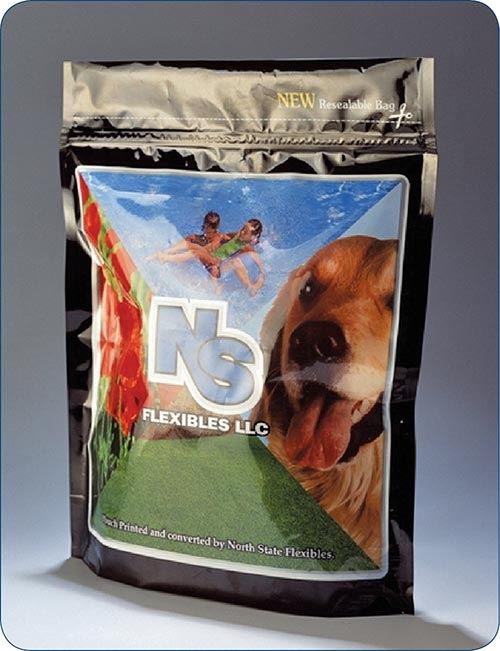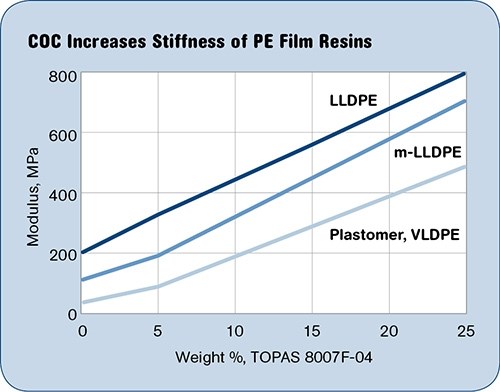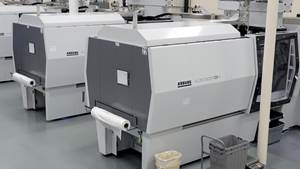Cyclic Olefin Copolymer Enhances Polyolefin Blends for Film Packaging
Tips and Techniques
Cyclic olefin copolymer (COC ) is an amorphous thermoplastic that is finding increased utility as a blending agent in polyolefin packaging films for medical, consumer, and industrial markets.
Cyclic olefin copolymer (COC ) is an amorphous thermoplastic that is finding increased utility as a blending agent in polyolefin packaging films for medical, consumer, and industrial markets. In neat form, COC offers high transparency, outstanding moisture barrier, high stiffness and strength, and excellent biocompatibility in such applications as medical devices, food and pharmaceutical packaging, optics, and electronics.
In polyolefin blends, COC provides higher modulus, greater heat resistance, and increased barrier for bags, pouches, and thermoformed articles such as trays. These blends are easily processed on conventional cast and blown film lines within standard polyolefin operating parameters.
Topas COC is based on the polymerization of ethylene and norbornene using metallocene catalysts. This material can have a glass-transition temperature (Tg) ranging from 33 C to 180 C, depending on comonomer ratio. As an amorphous polymer, COC does not have a crystalline melting point and instead starts to soften above the Tg, becoming increasingly fluid as temperatures are increased. This colorless, crystal-clear material offers strong compatibility with conventional polyethylenes. Its compatibility is greatest with highly linear PEs such as LLDPE but is acceptable for LDPE and HDPE. COC grades from Topas Advanced Polymers most commonly used for olefin blends are Topas 9903D-10 (Tg of 33 C), Topas 9506F-04 (Tg of 68 C), and Topas 8007F-04 (Tg of 78 C). Higher-Tg grades are sometimes used for special products or to enhance heat resistance of films.
STIFFNESS PERMITS DOWNGAUGING
COC is most commonly used as a blend component to enhance modulus and allow thickness reduction of monolayer films. With a modulus in the 300,000 psi range, as little as 10% of COC added to LLDPE will double or triple its modulus while maintaining low haze. In either a simple monolayer film or as part of a coextruded stucture, a LLDPE/COC blend often allows a thinner film to provide the same performance at a reduced cost per sq ft of film, thus offering important sustainability benefits.
With higher-Tg grades of COC, these modulus improvements are maintained up to temperatures approaching the Tg of the COC, improving the film’s hot-fill performance and elevated-temperature capability. An important point to remember is that addition of COC to LLDPE significantly reduces Elmendorf tear strength, especially in the machine direction, even as it improves the puncture resistance of the film. COC is utilized commercially as a controlled, linear-tear additive. Additionally, many olefin/COC films are used commercially in thermoforming applications where COC’s amorphous nature improves the uniformity of the forming process, allowing improved thickness control in deep-draw sections and corners.
LLDPE/COC blends are also a good fit for sealant films. Heat-seal performance is typically specified by seal strength, hot-tack strength, and seal initiation temperature. The increase in modulus for COC blends typically translates into 10% to 20% higher seal strength. As it cools, COC rapidly transitions from a rubbery material above its Tg to a high-modulus material below its Tg. This sharp change typically improves hot-tack (seal strength after 0.1 sec of cooling) by as much as 100%. Hot-tack strength is important for vertical form/fill/seal processes where contents are dropped into a bag while the seal is still hot. Increased overall modulus imparted by COC also enhances the “stand-up” performance of stand-up pouches. This makes the pouches easier to fill and handle.
COC is also being increasingly used in polyolefin blends to produce barrier films for packaging. COC has one of the highest moisture barriers of any polymer. Its performance is four to five times better than LDPE. Blends composed of more than 70% COC typically provide up to 90% of the barrier performance of neat COC and maintain low haze. COC is also an excellent barrier for many other polar solvents, such as the alcohols in hand sanitizers and antiseptic sponges, offering 35 times better barrier to ethanol than LLDPE. Usually these high-COC-content blends are used in coextruded films sandwiched by outer layers of LLDPE and do not require a tie layer.
COC also typically provides five to 10 times better barrier resistance to aromas and fragrances than LLDPE. Although COC is not considered to have a high gas barrier, it is still significantly better than polyethylene and can be used to tailor blends to meet the specific oxygen and carbon dioxide barrier required in fresh-produce packaging.
MINIMAL PROCESS ADJUSTMENTS
COC is generally compatible in blends at all ratios from 0 to 100% with all types of polyethylene. However, the best compatibility is with more linear polyolefins such as LLDPE. COC blends with these materials can be produced with little or no increase in haze. It is best to choose a PE grade based on the processing viscosity and the end-use properties needed. Good results have been obtained using PEs with melt indexes of 1.0 to 6.0 g/10 min at 190 C. COC does not require drying. It should not be stored at temperatures at or above its Tg to avoid pellet agglomeration.
For film manufacturing, COC and PE pellets should be mixed uniformly to produce a “salt-and-pepper” pellet blend. For COC/polyolefin blends, the process melt temperature typically depends on the Tg of the COC. Extrusion temperatures are typically 130° to 150° C above the COC’s Tg.
A key to production of a high-quality melt and resulting film is good mixing during extrusion. Recommended extruder screw speed is at least 50 rpm. If lower speeds must be used to accommodate throughput requirements, mixing can be increased by generating a higher extruder discharge pressure (>1500 psi) through use of a tighter screen pack. An extruder L/D of at least 24:1 and a low-compression screw design are recommended. Barrier mixing screws work best and Maddock-type mixing sections have proven effective but are not required. Typical coathanger cast film dies and spiral blown film dies are acceptable.
Other cast and blown film parameters are in line with those used for conventional PE. In blown film, the increased stiffness produced by a high COC level can cause challenges in achieving wrinkle-free bubble collapsing and layflat. In general, keeping the film warmer in the collapsing section will help. Equipment designed to handle stiff films made of HDPE and nylon will typically produce better results when producing stiff films with high COC content.
Topas COC is a thermally stable resin and resistant to the formation of gels, however, it may be desirable to purge COC from equipment for transitions or shutdowns. A typical purge may consist of 50% 1-MI LLDPE and 50% of a typical PE purge compound.
MEETS FOOD & MEDICAL SPECS
Topas COC grades comply with all major regulatory food-contact requirements. In the U.S., they comply with FDA regulation 21 CFR 177.1520 “olefin polymers” (3.9). The materials can be used in film, sheet, and other articles that come in direct contact with food under FDA FCN #75 and #405. This applies to all types of food and all conditions of use. The Tg of some grades results in a practical use-temperature limit.
Topas COC is also suitable for food-contact applications in Europe, where the monomers used in its manufacture are listed in the EU Plastics Directive 2002/72/EC1/2 (6 Aug. 2002). Manufacturers who use Topas COC should check any restrictions and migration limits on the finished article.
Topas COC is also approved for use in medical and pharmaceutical applications. A U.S. FDA Drug Master File (DMF #12132) and FDA Device Master File (MAF #1043) have been established for most Topas COC grades. Most grades are also USP Class VI compliant.
Related Content
‘Monomaterial’ Trend in Packaging and Beyond Will Only Thrive
In terms of sustainability measures, monomaterial structures are already making good headway and will evolve even further.
Read MoreABC Technologies to Acquire Windsor Mold Group Technologies
The Tier One automotive supplier with compounding and blowmolding machine capabilities adds the 50-yr-old molder and moldmaker.
Read MoreConsistent Shots for Consistent Shots
An integral supplier in the effort to fast-track COVID-19 vaccine deployment, Retractable Technologies turned to Arburg and its PressurePilot technology to help deliver more than 500 million syringes during the pandemic.
Read MoreHow to Optimize Injection Molding of PHA and PHA/PLA Blends
Here are processing guidelines aimed at both getting the PHA resin into the process without degrading it, and reducing residence time at melt temperatures.
Read MoreRead Next
Beyond Prototypes: 8 Ways the Plastics Industry Is Using 3D Printing
Plastics processors are finding applications for 3D printing around the plant and across the supply chain. Here are 8 examples to look for at NPE2024.
Read MoreLead the Conversation, Change the Conversation
Coverage of single-use plastics can be both misleading and demoralizing. Here are 10 tips for changing the perception of the plastics industry at your company and in your community.
Read More























